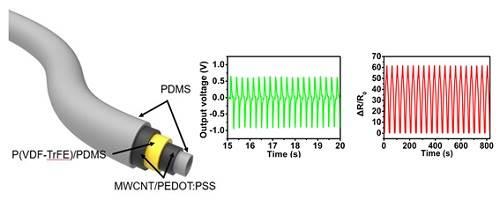With wearable electronics, health and physical conditions can be assessed by analysing biological signals from the human body, such as pulse and muscle movements. Fibres are highly suitable for future wearable electronics because they can be easily integrated into textiles, which are designed to be conformable to curvilinear surfaces and comfortable to wear. Moreover, their weave structures offer support that makes them resistant to fatigue. Many research groups have developed fibre-based strain sensors to sense external biological signals. However, their sensitivities were relatively low.
The applicability of wearable devices is currently limited by their power source, as the size, weight, and lifetime of the battery lessens their versatility. Harvesting mechanical energy from the human body is a promising solution to overcome such limitations by utilising various types of motions like bending, stretching, and pressing. However, previously reported, fibre-based energy harvesters were not stretchable and could not fully harvest the available mechanical energy.

Professor Seungbum Hong and Professor Steve Park from the Department of Materials Science and Engineering and their team fabricated a stretchable fibre by using a ferroelectric layer composed of P(VDF-TrFE)/PDMS sandwiched between stretchable electrodes composed of a composite of multi-walled carbon nanotubes (MWCNT) and poly 3,4-ethylenedioxythiophene polystyrenesulfonate (PEDOT:PSS).
Cracks formed in MWCNT/PEDOT:PSS layer help the fibre show high sensitivity compared to the previously reported fibre strain sensors. Furthermore, the new fibre can harvest mechanical energy under various mechanical stimuli such as stretching, tapping, and injecting water into the fibre using the piezoelectric effect of the P(VDF-TrFE)/PDMS layer.













